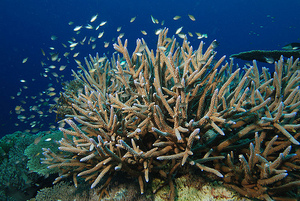Seaweeds, also known as macroalgae, can unleash a chemical arsenal toxic to corals, scientists have found.
Writing in PNAS, Georgia Institute of Technology researcher Douglas Rasher and his colleagues studied the sensiti vities of 3 different coral species to 8 different types of seaweed. Bringing the two together, as might occur on a reef, resulted in bleaching, reduced photosynthesis and even death of the corals in almost 80% of cases. Physical proximity wasn't the cause, the scientists confirmed. When plastic models of the offending macroalgae were substituted for the real thing, the corals remained healthy. Instead, it turns out that the seaweeds secrete a cocktail of oil-soluble chemicals called terpenes. These can rub off on the corals, killing them.
vities of 3 different coral species to 8 different types of seaweed. Bringing the two together, as might occur on a reef, resulted in bleaching, reduced photosynthesis and even death of the corals in almost 80% of cases. Physical proximity wasn't the cause, the scientists confirmed. When plastic models of the offending macroalgae were substituted for the real thing, the corals remained healthy. Instead, it turns out that the seaweeds secrete a cocktail of oil-soluble chemicals called terpenes. These can rub off on the corals, killing them.
The seaweed most likely use the chemicals as a means of anti-microbial defense. But corals can become croppers when reefs damaged by human activities and climate change are then invaded by the macroalgae, which are able to gain a toe-hold in the first place because the ruining the reef also renders the habitat untenable for herbivorous fish that would previously have kept the weeds in check. This, say the scientists, may well explain the lack of recovery seen on many present-day reefs...
- Previous Antiviral for Alzheimer's
- Next Cause of chronic fatigue?










Comments
Add a comment